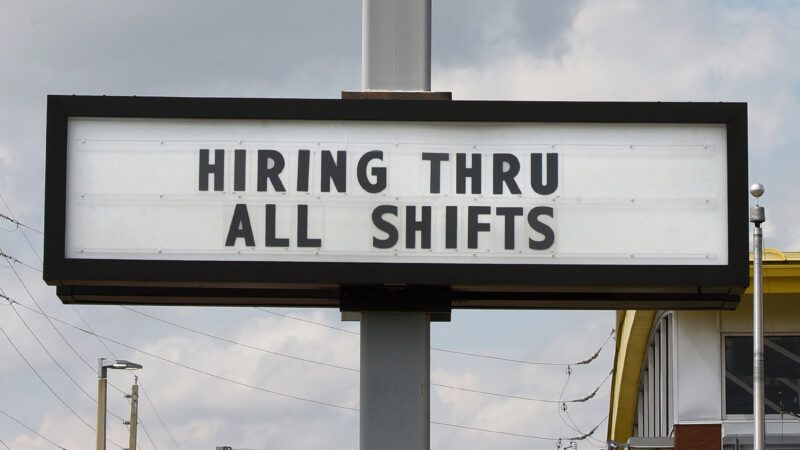Bad Jobs Numbers Raise More Questions About Unemployment Insurance
Is the problem government cash or have we entered a new paradigm?

(Paul Hennessy/ZUMAPRESS/Newscom)
The September jobs report released by the Bureau of Labor Statistics (BLS) showed that August's disappointing job growth was not a fluke. In an era of rushed reporting, motivated by 24-hour news cycles and politically weaponized talking points, we should always treat any single data point with a large grain of salt. Two in a row, however, suggests that a trend might be forming, warranting more careful attention.
For reasons we don't understand well, the labor market might be pivoting toward a period of slower growth, driven by a scarcity of available workers.
The most important problem facing the labor market is the return of workers to the workforce—or the lack thereof. The most recent BLS Job Openings and Labor Turnover Survey showed businesses seeking to fill a record 10.9 million jobs in July. That astonishing number is 44 percent higher than the pre-pandemic record. It also stands against 8.7 millionworkers who were counted as officially unemployed in July, which decreased to less than 7.7 million by September.
Therein lies the problem. Compared to the pre-pandemic labor market, there are 3.1 million fewer people currently participating in the workforce. But a simplistic pre-pandemic comparison isn't apt, since it doesn't include or address older workers' retirements and younger workers joining the workforce over the last 19 months. Pre-pandemic trends suggest a workforce around 5.75 million larger than it currently is.
We cannot, of course, ignore the labor market shock caused by COVID-19. The pandemic appears to have motivated many older workers to choose earlier-than-anticipated retirements (and who could blame them?). Early data showed a surge of retirements in April 2020, and later analysis estimates that 1.7 million more people identified as being retired in BLS surveys than the pre-pandemic trend would have predicted.
So let's say the workforce is about 4 million workers smaller than it otherwise should be. If these workers were all actively seeking jobs and thus counted as unemployed, rather than remaining outside the workforce, the current unemployment rate would be 7.1 percent.
Against this backdrop, the large decline in the unemployment rate from August to September (5.2 percent to 4.8 percent), combined with a relatively unchanged labor force participation rate, is a clear cause for concern. Workers are not rejoining the labor market, even after most of the reasons for reluctance have waned.
The biggest inhibition for many unemployed workers was likely fear of COVID-19. But with free and effective vaccines now widely available for adults and teenagers, the rationale sounds increasingly like an excuse. Booster shots are even now available for those at higher risk. The delta variant compounded fears over the summer, but its effects are understood to largely affect the unvaccinated, many of whom don't seem especially concerned about the disease anyway.
The second-most widely cited reason for workers remaining unemployed was the lack of child care due to remote schooling. But most school systems have resumed in-person teaching, including the nation's largest in New York City, which notably did not include a remote learning optionwhen classes resumed in mid-September. In fact, a majority of school districts were already offering in-person classes last spring.
NYC's first week of in-person schooling coincided with September BLS jobs report data collection, meaning that late-starting schools might have affected some workers' return to work. But the validity of this rationale has also been diminishing over time, and the lack of child care as a systematic constraint on caregivers' return to the workforce should be effectively resolved at this point.
The generosity of federally expanded unemployment insurance (U.I.) is the third mechanism that might have been inhibiting a return to the workforce. The barest mention of this fact provokes assertive refutationby some pundits and policy wonks, who argue that the first two rationales have been much more important.
September's jobs report adds fuel to this fire, because the expanded U.I. benefits ended a week before the data were collected. The lack of a resurgence in job growth, the pro-U.I. pundits argue, is evidence that the benefits weren't deterring people from working.
If that's true, we face a true dilemma: Our best explanations for why the workforce isn't quickly returning to its pre-pandemic state would all be invalidated. We shouldn't be so quick to throw out the U.I.-based explanation, however.
The federally expanded U.I. programs famously exceeded prior income for many workers, and there are many anecdotes of workers squirreling away the extra cash for the future. It's a good strategy to hold out for a high-quality job offer rather than taking the first one that comes along.
In reality, all three rationales probably still matter, but the disincentive of federally expanded U.I. benefits seems to have the largest effect today, even after the end of the federal programs.
That leaves the question of how long it will take for the 4 million missing workers to be sufficiently motivated to rejoin the workforce. My fear is that labor scarcity combined with customer demands will motivate employers to shift even faster to adopt automation and labor-saving technologies. This could lead to the last unemployed workers discovering that the jobs they were holding out for have evaporated. A classic case of the early bird being right after all.
We should also consider that perhaps the economy has entered a completely new paradigm—one in which a subset of workers have discovered that they can get by on very little, and who view lots of leisure time as a sufficient tradeoff. After all, preferences change, and markets change with them.
In short, no one can authoritatively list the single reason why workforce growth is so slow, or where all the "missing" workers are. But we should watch closely as more data become available. After all, the future arrives one day at a time, and no faster.
